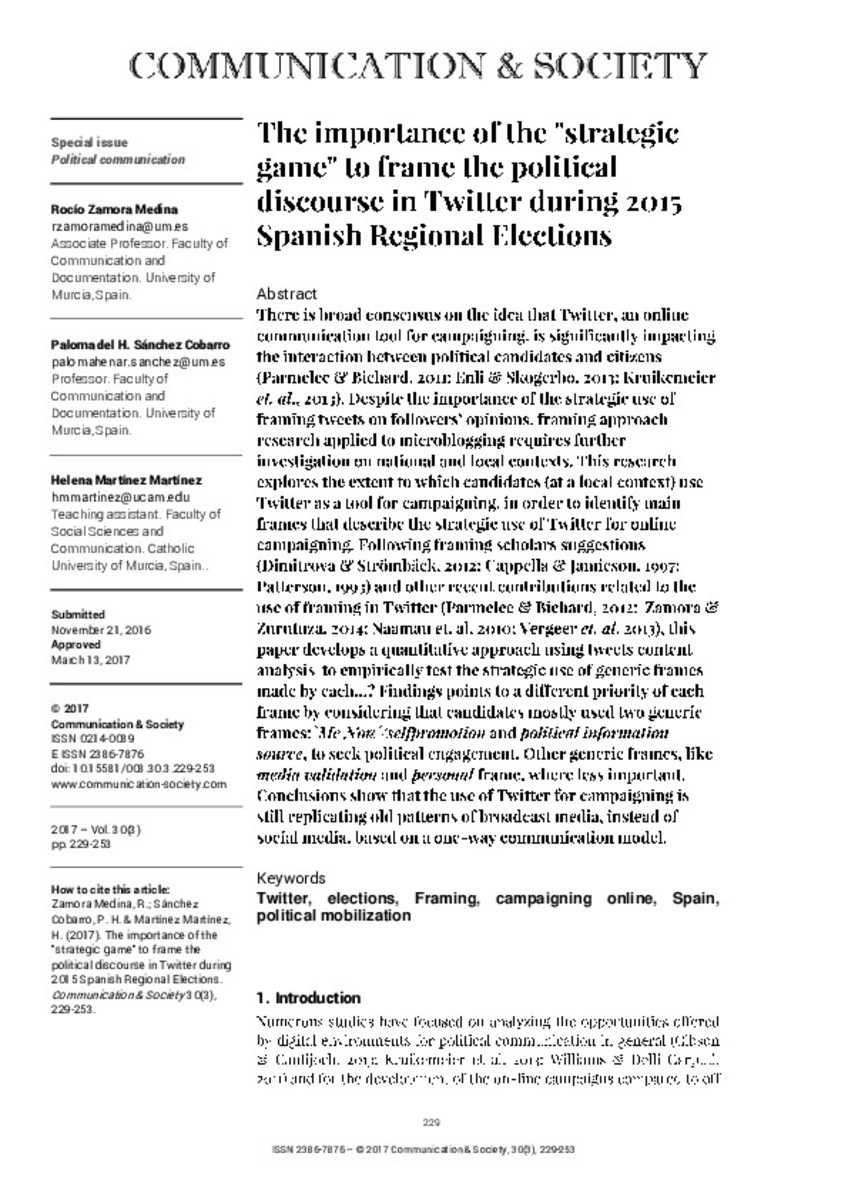Full metadata record
| DC Field | Value | Language |
|---|---|---|
| dc.creator | Zamora-Medina, R. (Rocío) | - |
| dc.creator | Sánchez-Cobarro, M. (Paloma del H.) | - |
| dc.creator | Martínez-Martínez, H. (Helena) | - |
| dc.date.accessioned | 2017-09-26T11:12:21Z | - |
| dc.date.available | 2017-09-26T11:12:21Z | - |
| dc.date.issued | 2017 | - |
| dc.identifier.citation | Zamora-Medina, R. (Rocío); Sánchez-Cobarro, M. (Paloma del H.); Martínez-Martínez, H. (Helena). "The importance of the ”strategic game” to frame the political discourse in Twitter during 2015 Spanish Regional Elections". Communication & Society. 30 (3), 2017, 229 - 253 | es |
| dc.identifier.issn | 2386-7876 | - |
| dc.identifier.uri | https://hdl.handle.net/10171/43937 | - |
| dc.description.abstract | There is broad consensus on the idea that Twitter, an online communication tool for campaigning, is significantly impacting the interaction between political candidates and citizens (Parmelee & Bichard, 2011; Enli & Skogerbo, 2013; Kruikemeier et. al., 2013). Despite the importance of the strategic use of framing tweets on followers’ opinions, framing approach research applied to microblogging requires further investigation on national and local contexts. This research explores the extent to which candidates (at a local context) use Twitter as a tool for campaigning, in order to identify main frames that describe the strategic use of Twitter for online campaigning. Following framing scholars suggestions (Dimitrova & Strömbäck, 2012; Cappella & Jamieson, 1997; Patterson, 1993) and other recent contributions related to the use of framing in Twitter (Parmelee & Bichard, 2012; Zamora & Zurutuza, 2014; Naaman et. al, 2010; Vergeer et. al. 2013), this paper develops a quantitative approach using tweets content analysis to empirically test the strategic use of generic frames made by each…? Findings points to a different priority of each frame by considering that candidates mostly used two generic frames: `Me Now´/selfpromotion and political information source, to seek political engagement. Other generic frames, like media validation and personal frame, where less important. Conclusions show that the use of Twitter for campaigning is still replicating old patterns of broadcast media, instead of social media, based on a one-way communication model. | es_ES |
| dc.language.iso | eng | es_ES |
| dc.publisher | Servicio de Publicaciones de la Universidad de Navarra | es_ES |
| dc.rights | info:eu-repo/semantics/openAccess | es_ES |
| dc.subject | es_ES | |
| dc.subject | elections | es_ES |
| dc.subject | Framing | es_ES |
| dc.subject | campaigning online | es_ES |
| dc.subject | Spain | es_ES |
| dc.subject | political mobilization | es_ES |
| dc.title | The importance of the ”strategic game” to frame the political discourse in Twitter during 2015 Spanish Regional Elections | es_ES |
| dc.type | info:eu-repo/semantics/article | es_ES |
| dc.identifier.doi | 10.15581/003.30.35777 | es_ES |
| dadun.citation.endingPage | 253 | es_ES |
| dadun.citation.number | 3 | es_ES |
| dadun.citation.publicationName | Communication & Society | es_ES |
| dadun.citation.startingPage | 229 | es_ES |
| dadun.citation.volume | 30 | es_ES |
Files in This Item:
Statistics and impact
Items in Dadun are protected by copyright, with all rights reserved, unless otherwise indicated.






